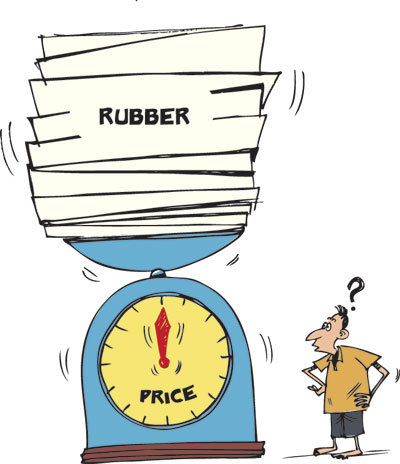Reply To:
Name - Reply Comment
_City-DM-10-T.jpg) he crisis in the local rubber industry has deepened as prices continue to collapse. At the latest rubber auction in Colombo, the top grades -- Latex Crepe 1X and Latex Crepe 1, 2, and 3 were unquoted. The prices of Ribbed Smoked Sheet (RSS) were lagging at Rs.248.
he crisis in the local rubber industry has deepened as prices continue to collapse. At the latest rubber auction in Colombo, the top grades -- Latex Crepe 1X and Latex Crepe 1, 2, and 3 were unquoted. The prices of Ribbed Smoked Sheet (RSS) were lagging at Rs.248.
According to the Colombo Rubber Traders’ Association (CRTA), the rubber auction prices have fallen 50 per cent over the past three years. The current latex rubber price (latex crepe 1x and 1) hovers around Rs.300 to 320 a kilo whereas the prices were at Rs.600 in 2011.
Smallholders produce the bulk of Sri Lanka’s rubber output -- about 63 per cent -- while estates, including the Regional Plantation Companies, account for the rest.
According to CRTA Chairman M.S. Rahim, natural rubber prices are expected to decline further as a result of a slowdown in major economies, excess production coming from new producers and stockpiles which are estimated at 300,000 tonnes in China, the largest consumer of natural rubber.
Meanwhile, with the natural-rubber prices declining in the international market place, the local rubber production, too is on a downward trend.
 According to the Central Bank, Sri Lanka’s rubber production declined by 14.2 per cent to 130,421 metric tonnes in 2013 compared to 2012. In 2011, the rubber output stood at 158,000 tonnes.
According to the Central Bank, Sri Lanka’s rubber production declined by 14.2 per cent to 130,421 metric tonnes in 2013 compared to 2012. In 2011, the rubber output stood at 158,000 tonnes.
According to the CRTA, one of the key reasons for the drop in production is possibly the lower productivity of smallholders who account for a total of 79,395 hectares, of which the data on yield per hectare is not currently available.
Meanwhile, the margins of Sri Lankan rubber producers are getting thinner amid escalating production costs.
For smallholders, the production cost of a kilo of RSS is estimated at Rs.148 while for Regional Plantation Companies the number stands at Rs.220, as a result of the Plantation Workers’ Collective Agreement according to which the wages of plantation workers is revised every two years.
According to Regional Plantation Companies, the cost of production rose by Rs.20-25 a kilo following the latest plantation worker wage increase.
“The quantity of rubber entering the Colombo rubber auction is reducing day by day. Most of the rubber traders have run out of stocks. It won’t be long before rubber-based manufacturers will have to import a bulk of their natural rubber requirements,” Mr. Rahim said.
Meanwhile, rubber-based manufacturers have requested the government to lift the Cess on imported raw rubber to mitigate the impact from local rubber production bottlenecks.
The Export Development Board and Malaysia’s Confexhub together with Sri Lanka’s Industry and Commerce Ministry and the Plantation Industry Minister are organising a Global Rubber Conference in Sri Lanka this month. Such a conference no doubt will be vital for the development of the rubber industry, but the government, relevant ministries and authorities need to find ways to address the immediate crisis in the rubber sector.